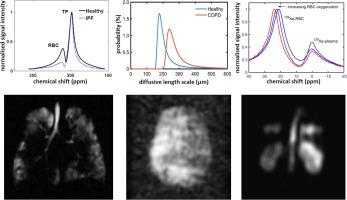当前位置:
X-MOL 学术
›
Prog. Nucl. Magn. Reson. Spectrosc.
›
论文详情
Our official English website, www.x-mol.net, welcomes your feedback! (Note: you will need to create a separate account there.)
In Vivo Methods and Applications of Xenon-129 Magnetic Resonance
Progress in Nuclear Magnetic Resonance Spectroscopy ( IF 6.1 ) Pub Date : 2021-02-01 , DOI: 10.1016/j.pnmrs.2020.11.002 Helen Marshall 1 , Neil J Stewart 1 , Ho-Fung Chan 1 , Madhwesha Rao 1 , Graham Norquay 1 , Jim M Wild 1
Progress in Nuclear Magnetic Resonance Spectroscopy ( IF 6.1 ) Pub Date : 2021-02-01 , DOI: 10.1016/j.pnmrs.2020.11.002 Helen Marshall 1 , Neil J Stewart 1 , Ho-Fung Chan 1 , Madhwesha Rao 1 , Graham Norquay 1 , Jim M Wild 1
Affiliation

|
Abstract Hyperpolarised gas lung MRI using xenon-129 can provide detailed 3D images of the ventilated lung airspaces, and can be applied to quantify lung microstructure and detailed aspects of lung function such as gas exchange. It is sensitive to functional and structural changes in early lung disease and can be used in longitudinal studies of disease progression and therapy response. The ability of 129Xe to dissolve into the blood stream and its chemical shift sensitivity to its local environment allow monitoring of gas exchange in the lungs, perfusion of the brain and kidneys, and blood oxygenation. This article reviews the methods and applications of in vivo 129Xe MR in humans, with a focus on the physics of polarisation by optical pumping, radiofrequency coil and pulse sequence design, and the in vivo applications of 129Xe MRI and MRS to examine lung ventilation, microstructure and gas exchange, blood oxygenation, and perfusion of the brain and kidneys.
中文翻译:

Xenon-129 磁共振的体内方法和应用
摘要 使用氙 129 的超极化气体肺 MRI 可以提供通气肺空域的详细 3D 图像,并可用于量化肺微观结构和肺功能的详细方面,例如气体交换。它对早期肺部疾病的功能和结构变化敏感,可用于疾病进展和治疗反应的纵向研究。129Xe 溶解到血流中的能力及其对局部环境的化学位移敏感性允许监测肺部的气体交换、大脑和肾脏的灌注以及血液氧合。本文回顾了体内 129Xe MR 在人体中的方法和应用,重点关注通过光泵浦、射频线圈和脉冲序列设计的极化物理,
更新日期:2021-02-01
中文翻译:

Xenon-129 磁共振的体内方法和应用
摘要 使用氙 129 的超极化气体肺 MRI 可以提供通气肺空域的详细 3D 图像,并可用于量化肺微观结构和肺功能的详细方面,例如气体交换。它对早期肺部疾病的功能和结构变化敏感,可用于疾病进展和治疗反应的纵向研究。129Xe 溶解到血流中的能力及其对局部环境的化学位移敏感性允许监测肺部的气体交换、大脑和肾脏的灌注以及血液氧合。本文回顾了体内 129Xe MR 在人体中的方法和应用,重点关注通过光泵浦、射频线圈和脉冲序列设计的极化物理,































 京公网安备 11010802027423号
京公网安备 11010802027423号